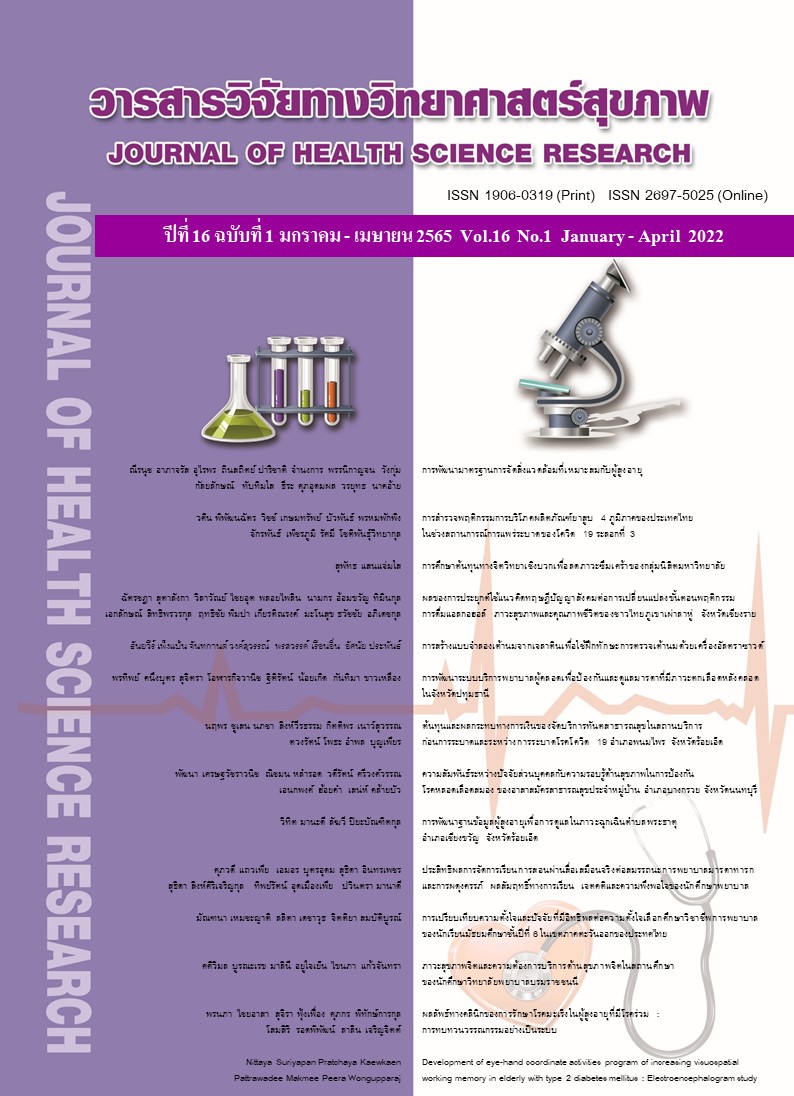การพัฒนาโปรแกรมการกระตุ้นประสานสัมพันธ์ตาและมือ ในการเพิ่มความจำขณะคิดด้านภาพและมิติสัมพันธ์ของผู้สูงอายุที่เป็นโรคเบาหวานชนิดที่ 2 : การศึกษาคลื่นไฟฟ้าสมอง
Main Article Content
บทคัดย่อ
บทนำ : การพัฒนาโปรแกรมการกระตุ้นประสานสัมพันธ์ตาและมือในการเพิ่มความจำขณะคิดด้านภาพ และมิติสัมพันธ์ของผู้สูงอายุที่เป็นโรคเบาหวานชนิดที่ 2 เป็นประโยชน์ต่อสุขภาพและคุณภาพชีวิตที่ดีขึ้น
วัตถุประสงค์การวิจัย : พัฒนาโปรแกรมการกระตุ้นประสานสัมพันธ์ตาและมือ และเพื่อเปรียบเทียบผลการใช้โปรแกรมการกระตุ้นประสานสัมพันธ์ตาและมือ จากกิจกรรมทดสอบความจำขณะคิดด้านภาพและมิติสัมพันธ์ รวมทั้งศึกษาคลื่นไฟฟ้าสมอง (คลื่นอัลฟ่า คลื่นเบต้า) ระหว่างกลุ่มทดลองและกลุ่มควบคุม
วิธีการวิจัย : เป็นการวิจัยเชิงทดลอง คัดเลือกอาสาสมัครจากชมรมผู้สูงอายุ คลินิกโรคเรื้อรัง โรงพยาบาลท่าเรือ อำเภอท่าเรือ จังหวัดพระนครศรีอยุธยา ประเทศไทย จำนวน 60 คน อายุระหว่าง 60-75 ปี แบ่งเป็นกลุ่มทดลองและกลุ่มควบคุม โปรแกรมการฝึกมี 3 ช่วง ช่วงละ 27 นาที จำนวน 14 ครั้ง เครื่องมือที่ใช้ในการศึกษาคือ Psychology Experiment Building Language, Corsi Block-Tapping Task, Emotiv EPOC EEG headset, MMSE, PHQ-9, WHOQOL และ ST-5 การวิเคราะห์ข้อมูลโดยใช้การทดสอบค่าที
ผลการวิจัย : พบว่าโปรแกรมการกระตุ้นประสานสัมพันธ์ตาและมือมีการพัฒนาอย่างมีประสิทธิ ภาพ และกลุ่มทดลองที่ได้รับการฝึกโปรแกรมอย่างเป็นประจำ มีคุณภาพชีวิตเพิ่มขึ้น ผลการทดสอบสภาพสมองเสื่อมเบื้องต้นลดลง ระดับความเครียดและภาวะซึมเศร้าลดลง โดยมีช่วงของความจำเพิ่มขึ้น นอกจากนี้ กลุ่มทดลองมีคลื่นอัลฟ่าและคลื่นเบต้าที่สมองบริเวณส่วนหน้า ส่วนพาไรทัล และส่วนท้าย สูงกว่ากลุ่มควบคุมหลังได้รับการฝึกโปรแกรมการฝึก อย่างมีนัยสำคัญทางสถิติที่ระดับ .05
สรุปผล : โปรแกรมการกระตุ้นประสานสัมพันธ์ตาและมือ สามารถเพิ่มความจำขณะคิดด้านภาพและ มิติสัมพันธ์ของผู้สูงอายุที่เป็นโรคเบาหวานชนิดที่ 2
Downloads
Article Details

อนุญาตภายใต้เงื่อนไข Creative Commons Attribution-NonCommercial-NoDerivatives 4.0 International License.
บทความที่ได้รับการตีพิมพ์เป็นลิขสิทธิ์ของวิทยาลัยพยาบาลบรมราชชนนี จังหวัดนนทบุรี
ข้อความที่ปรากฏในบทความแต่ละเรื่องในวารสารวิชาการเล่มนี้เป็นความคิดเห็นส่วนตัวของผู้เขียนแต่ละท่านไม่เกี่ยวข้องกับวิทยาลัยพยาบาลบรมราชชนนี จังหวัดนนทบุรี และคณาจารย์ท่านอื่น ในวิทยาลัยฯ แต่อย่างใด ความรับผิดชอบองค์ประกอบทั้งหมดของบทความแต่ละเรื่องเป็นของผู้เขียนแต่ละท่าน หากมีความผิดพลาดใด ๆ ผู้เขียนแต่ละท่านจะรับผิดชอบบทความของตนเองแต่ผู้เดียว
เอกสารอ้างอิง
Andrews RC, Herlihy O, Livingstone DE, Andrew R, Walker BR. Abnormal cortisol metabolism and tissue sensitivity to cortisol in patients with glucose intolerance. J Clin Endocrinol Metab. 2002;87(12):5587-93. doi: 10.1210/jc.2002-020048.
Chiodini I, Torlontano M, Scillitani A, Arosio M, Bacci S, Di Lembo S, et al. Association of subclinical hypercortisolism with type 2 diabetes mellitus: a case-control study in hospitalized patients. Eur J Endocrinology. 2005;153(6):837-44. doi: 10. 1530/eje.1.02045.
Coiro V, Volpi R, Capretti L, Speroni G, Caffarra P, Scaglioni A, et al. Low-dose ovine corticotropin-releasing hormone stimulation test in diabetes mellitus with or without neuropathy. Metabolism. 1995;44(4): 538-42. doi: 10.1016/0026-0495(95)90064-0.
Cameron OG, Thomas B, Tiongco D, Hariharan M, Greden JF. Hypercortisolism in diabetes mellitus. Diabetes Care. 1987;10 (5):662–4. doi: 10.2337/diacare.10.5.662.
Roy M, Collier B, Roy A. Hypothalamic-pituitary-adrenal axis dysregulation among diabetic outpatients. Psychiatric Res. 1990; 31(1):31–7. doi: 10.1016/0165-1781(90)90106-f.
Hudson JI, Hudson MS, Rothschild AJ, Vignati L, Schatzberg AF, Melby JC. Abnormal results of dexamethasone suppression tests in nondepressed patients with diabetes mellitus. Arch Gen Psychiatry. 1984;41(11):1086-9. doi: 10.1001/archpsyc. 1983.01790220076012.
Liu H, Bravata DM, Cabaccan J, Raffa H, Ryzen E. Elevated late-night salivary cortisol levels in elderly male type 2 diabetic veterans. Clin Endocrinol (Oxf). 2005;63:(6):642–9. doi: 10.1111/j.1365-2265.2005.02395.x.
Ogama N, Sakurai T, Kawashima S, Tanikawa T, Tokuda H, Satake S, et al. Association of glucose fluctuations with sarcopenia in older adults with type 2 diabetes mellitus. J Clin Med. 2019;8(3): 319. doi: 10.3390/jcm8030319.
Spanakis EK, Wang X, Sánchez BN, Diez Roux AV, Needham BL, et al. Lack of significant association between type 2 diabetes mellitus with longitudinal change in diurnal salivary cortisol: the multiethnic study of atherosclerosis. Endocrine. 2016;53(1): 227-39. doi: 10.1007/s12020-016-0887-8.
Oltmanns KM, Dodt B, Schultes B, Raspe HH, Schweiger U, et al. Cortisol correlates with metabolic disturbances in a population study of type 2 diabetic patients. Eur J Endocrinol. 2006;154(2):325–31. doi: 10.1530/eje.1.02074.
Baddeley AD, Hitch GJ. Development of working memory: Should the Pascual-Leone and the Baddeley and Hitch models be merged?. J Exp Child Psychol. 2000;77 (2):128-37. doi: 10.100 6/jecp.2000.2592.
Garden S, Cornoldi C, Logie RH. Visuo‐spatial working memory in navigation. Appl Cogn Psychol. 2002;16(1):35-50. doi: 10.1002/acp.746.
Berch DB, Krikorian R, Huha EM. The Corsi block-tapping task: methodological and theoretical considerations. Brain Cogn. 1998;38(3):317-38. doi. 10.1006/brcg.1998.1039.
King H, Aubert RE, Herman WH. Global burden of diabetes, 1995-2025: prevalence, numerical estimates, and projections. Diabetes Care. 1998;21(9):1414-31. doi: 10.2337/diacare.21.9.1414.
Delorme A, Makeig S. EEGLAB: an open source toolbox for analysis of single-trial EEG dynamics including independent component analysis. J Neurosci Methods. 2004;134(1):9-21. doi: 10.1016/j.jneumeth. 2003.10.009.
Hair JF, Sarstedt M, Ringle CM, Mena JA. An assessment of the use of partial least squares structural equation modeling in marketing research. J. Acad. Mark. Sci. 2012; 40(3):414-33. doi: 10.1007/s11747-011-0261-6.
Klimesch W. a-band oscillations, attention, and controlled access to stored information. Trends Cogn Sci. 2012;16(12):606-17. doi: 10.1016/j.tics.2012.10.007.
Proskovec AL, Wiesman AI, Heinrichs-Graham E, Wilson TW. Beta oscillatory dynamics in the prefrontal and superior temporal cortices predict spatial working memory performance. Sci Rep. 2018;8(1): 1-13. doi:10.1038/s41598-018-26863-x.
Spachtholz P, Kuhbandner C, Pekrun R. Negative affect improves the quality of memories: Trading capacity for precision in sensory and working memory. J Exp Psychol Gen. 2014;143(4):1450-6. doi: 10.1037/xge0000012.
Wang JR, Hsieh S. Neurofeedback training improves attention and working memory performance. Clin Neurophysiol. 2013;124(12): 2406-20. doi: 10.1016/j.clinph.2013.05.020.
Pei YC, Chou SW, Lin PS, Lin YC, Hsu TH, Wong AM. Eye-hand coordination of elderly people who practice Tai Chi Chuan. J Formos Med Assoc. 2008;107(2):103-10. doi: 10.1016/S0929-6646(08) 60123-0.
Stessman J, Jacobs JM. Diabetes mellitus, physical activity, and longevity between the ages of 70 and 90. J Am Geriatr Soc. 2014;62(7):1329-34. doi: 10.1111/jgs.12930.
Gill JM, Cooper AR. Physical activity and prevention of type 2 diabetes mellitus. Sports Med. 2008;38(10):807-24. doi: 10.2165/0000 7256-200838100-00002.


